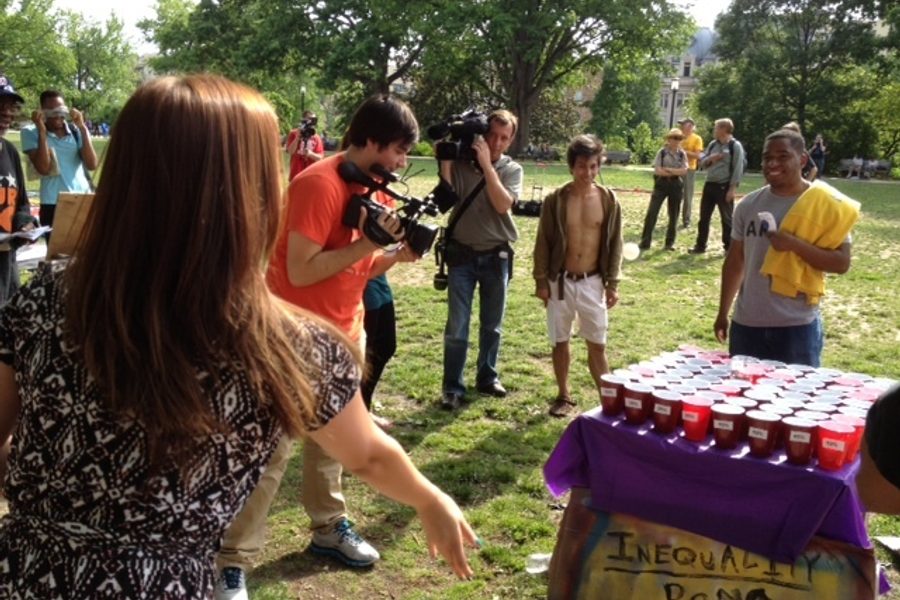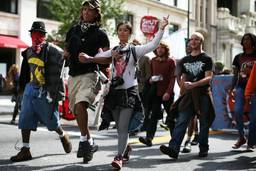
As New York swelled with up to 30,000 May Day demonstrators on Broadway, and as parts of the West Coast exploded with tear gas and broken windows, Washington, D.C., held a carnival.
On a holiday that draws attention to workers’ rights in the industrial era, D.C.’s event was downright medieval. On a sunny day in Meridian Hill Park, protesters danced around a maypole (held aloft manually when the cops said it couldn’t be planted in the soil), sang ancient labor ballads, hung out in the shade of trees, and erected a massive “sun dragon” puppet for the later march to the White House.
The atmosphere was festive and often whimsical. A game of “inequality pong” (with water, not beer) enticed players to aim for the 1 percent wine glass and avoid the 99 percent red Solo cups — and for an extra challenge, stand further back on the line for “poor dad” instead of the close-up “rich dad.” There was T-shirt silk-screening and purple glitter body paint. There were leaflets and models of foreclosed homes. One anarchist held his 5-week-old baby, and another anarchist gave a lecture on how chaos and disorder are actually the opposite of what anarchism seeks to achieve.
But fun and games aside, the central focus was on labor issues. One teach-in took attendees through the fraught history of organized labor and the bane of the Taft-Hartley Act. Numerous community and labor organizers took the stage, and several Metro employees in uniform could be seen around the park pushing for fairer deals.
Construction workers on scaffolds cheered on the activists as they left the park around 6:30 and took first half, then all, of 14th Street, chanting “The whole world is striking!”
A few hundred people gathered for the event, which was co-sponsored by the Anarchist Alliance DC Network, Occupy DC’s Labor Committee, Industrial Workers of the World, the Washington Peace Center, and other groups.
Some were disappointed that the turnout wasn’t higher, but others celebrated it as an Occupy reunion, the biggest DC May Day action in recent memory, and perhaps the largest Occupy action since the camp at McPherson Square was evicted in February.
Washington D.C.’s Occupy movement has always been a little different from those in other major cities. It was among the longest lasting encampments and the least disturbed by law enforcement (with a few notable exceptions, including the surprisingly violent NYPD-aided eviction). Sanitary issues and other conflicts aside, life was more tranquil there.
“We were really spoiled,” said protester Ryan Lash, who said he was lucky enough to have friends to stay with in D.C. after the eviction. “We had a camp for four months. We were able to establish a lot of friendships and connections.”
In the months since the eviction, Occupy DC has kept busy blocking foreclosures with Occupy Our Homes, the wonky policy initiative Occupy the SEC, and Sleepful Protests outside of Bank of America branches.
Without their home base, though, D.C. occupiers have had some trouble rallying the troops. Most of their recent marches have been enthusiastic but somewhat sparsely attended.
For now, at least, taking May Day back to a primal celebration of spring and renewal has breathed some new life into Occupy DC.

I hope you found this article important. Before you leave, I want to ask you to consider supporting our work with a donation. In These Times needs readers like you to help sustain our mission. We don’t depend on—or want—corporate advertising or deep-pocketed billionaires to fund our journalism. We’re supported by you, the reader, so we can focus on covering the issues that matter most to the progressive movement without fear or compromise.
Our work isn’t hidden behind a paywall because of people like you who support our journalism. We want to keep it that way. If you value the work we do and the movements we cover, please consider donating to In These Times.

